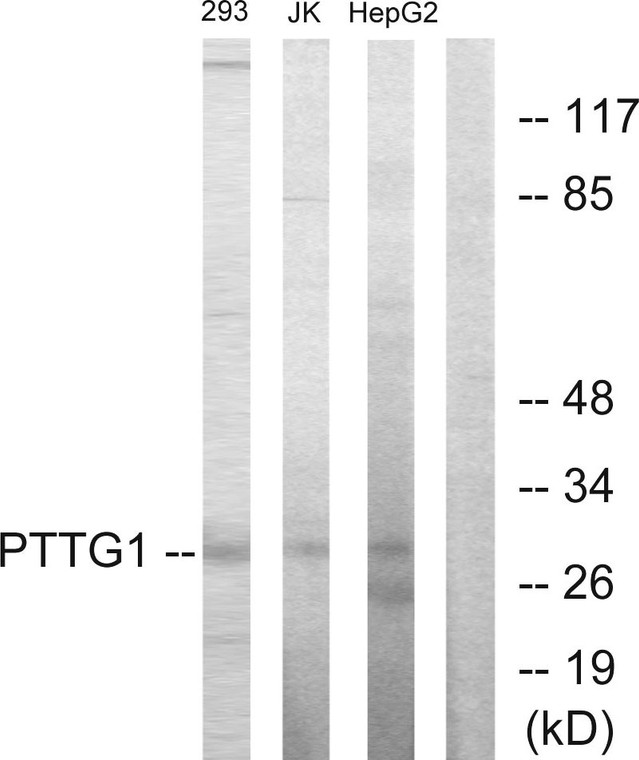| Host: |
Rabbit |
| Applications: |
WB/IHC/IF/ELISA |
| Reactivity: |
Human/Rat/Mouse |
| Note: |
STRICTLY FOR FURTHER SCIENTIFIC RESEARCH USE ONLY (RUO). MUST NOT TO BE USED IN DIAGNOSTIC OR THERAPEUTIC APPLICATIONS. |
| Short Description: |
Rabbit polyclonal antibody anti-Securin (111-160 aa) is suitable for use in Western Blot, Immunohistochemistry, Immunofluorescence and ELISA research applications. |
| Clonality: |
Polyclonal |
| Conjugation: |
Unconjugated |
| Isotype: |
IgG |
| Formulation: |
Liquid in PBS containing 50% Glycerol, 0.5% BSA and 0.02% Sodium Azide. |
| Purification: |
The antibody was affinity-purified from rabbit antiserum by affinity-chromatography using epitope-specific immunogen. |
| Concentration: |
1 mg/mL |
| Dilution Range: |
WB 1:500-1:2000IHC 1:100-1:300IF 1:200-1:1000ELISA 1:20000 |
| Storage Instruction: |
Store at-20°C for up to 1 year from the date of receipt, and avoid repeat freeze-thaw cycles. |
| Gene Symbol: |
PTTG1 |
| Gene ID: |
9232 |
| Uniprot ID: |
PTTG1_HUMAN |
| Immunogen Region: |
111-160 aa |
| Specificity: |
PTTG1/2/3 Polyclonal Antibody detects endogenous levels of PTTG1/2/3 protein. |
| Immunogen: |
The antiserum was produced against synthesized peptide derived from the human PTTG1 at the amino acid range 111-160 |
| Post Translational Modifications | Phosphorylated at Ser-165 by CDK1 during mitosis. Phosphorylated in vitro by ds-DNA kinase. Ubiquitinated through 'Lys-11' linkage of ubiquitin moieties by the anaphase promoting complex (APC) at the onset of anaphase, conducting to its degradation. 'Lys-11'-linked ubiquitination is mediated by the E2 ligase UBE2C/UBCH10. |
| Function | Regulatory protein, which plays a central role in chromosome stability, in the p53/TP53 pathway, and DNA repair. Probably acts by blocking the action of key proteins. During the mitosis, it blocks Separase/ESPL1 function, preventing the proteolysis of the cohesin complex and the subsequent segregation of the chromosomes. At the onset of anaphase, it is ubiquitinated, conducting to its destruction and to the liberation of ESPL1. Its function is however not limited to a blocking activity, since it is required to activate ESPL1. Negatively regulates the transcriptional activity and related apoptosis activity of TP53. The negative regulation of TP53 may explain the strong transforming capability of the protein when it is overexpressed. May also play a role in DNA repair via its interaction with Ku, possibly by connecting DNA damage-response pathways with sister chromatid separation. |
| Protein Name | SecurinEsp1-Associated ProteinPituitary Tumor-Transforming Gene 1 ProteinTumor-Transforming Protein 1Hpttg |
| Database Links | Reactome: R-HSA-174154Reactome: R-HSA-174178Reactome: R-HSA-2467813 |
| Cellular Localisation | CytoplasmNucleus |
| Alternative Antibody Names | Anti-Securin antibodyAnti-Esp1-Associated Protein antibodyAnti-Pituitary Tumor-Transforming Gene 1 Protein antibodyAnti-Tumor-Transforming Protein 1 antibodyAnti-Hpttg antibodyAnti-PTTG1 antibodyAnti-EAP1 antibodyAnti-PTTG antibodyAnti-TUTR1 antibody |
Information sourced from Uniprot.org
12 months for antibodies. 6 months for ELISA Kits. Please see website T&Cs for further guidance









